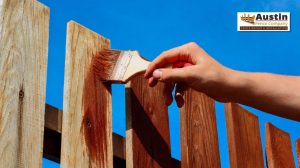
Table of Contents
ToggleTL;DR
In Austin, fences should be stained every 2–3 years to protect against sun, humidity, and storms. Transparent stains may need reapplication every 1–2 years, while solid stains can last up to 5 years. New fences require a waiting period of 3–6 months before the first stain. Climate, wood type, and HOA rules all affect staining frequency.
Table of Contents
Why Fence Staining Frequency Matters in Austin
Austin’s sun, humidity, and heavy rains accelerate wood damage. Without regular staining:

- Wood absorbs water, leading to rot and insect infestations.
- UV rays fade and crack boards.
- Fences deteriorate faster, leading to costly replacements.
Helpful read: The Ultimate Guide to Fence Staining in Austin
General Staining Guidelines for Wood Fences
- Standard recommendation: Every 2–3 years.
- Well-shaded fences: May last closer to 3 years.
- Full sun exposure: May need touch-ups in 18–24 months.
Service link: Fence Staining in Austin
New Fences: When to Apply the First Stain
- Wait 3–6 months for wood to dry and settle.
- Pressure-treated wood requires even longer to dry.
- Pro tip: Sprinkle water—if it beads, wait; if it soaks in, the wood is ready.
Transparent vs Semi-Transparent vs Solid Stains
Stain Type | Lifespan in Austin | Reapplication Frequency |
Transparent | 1–2 years | Frequent re-staining needed |
Semi-Transparent | 2–3 years | Best balance of beauty & protection |
Solid | 3–5 years | Longest-lasting, but hides wood grain |
Helpful read: Best Fence Stains for Austin Weather Conditions
How Austin’s Climate Affects Staining Frequency

- Heat & UV: Accelerate fading and drying.
- Humidity: Promotes mildew and rot.
- Storms: Wear down coatings faster.
- Soil moisture: Constant ground contact weakens posts.
Austin homeowners should inspect fences annually and re-stain sooner if signs of wear appear.
Signs It’s Time to Re-Stain Your Fence
- Water soaks into wood instead of beading.
- Color has noticeably faded.
- Boards feel rough, cracked, or splintering.
- Mildew or dark spots appear.
- HOA notices the fence looks weathered.
Helpful read: Fence Maintenance Best Practices
HOA Rules and Neighborhood Requirements
Many Austin HOAs require fences to be kept stained in cedar or neutral tones. Neglecting staining can:
- Lead to violation notices.
- Result in HOA fines.
- Force homeowners to re-stain sooner than planned.
DIY vs Professional Staining Schedules
- DIY Staining: Homeowners may need to stain more frequently if prep and application aren’t perfect.
- Professional Staining: Pros use higher-quality stains and equipment, ensuring 2–3 years of reliable protection.
Helpful read: DIY vs Professional Fence Installation in Austin
FAQs
How often should I stain my cedar fence in Austin?
Every 2–3 years, depending on sun and weather exposure.
Can I stain my fence too often?
Yes—over-staining can cause blotching. Stick to 2–3 years or when protection fades.
How do I know when my fence needs re-staining?
If water no longer beads on the surface, it’s time.
Do transparent stains need more frequent application?
Yes, usually every 1–2 years in Austin.
Does my HOA dictate stain frequency?
Some HOAs don’t set exact timelines but require fences to remain in good condition.
 Keep Your Fence Protected with Regular Staining
Keep Your Fence Protected with Regular Staining
Regular staining keeps your fence strong, attractive, and HOA-compliant, even in Austin’s harsh climate. By following a 2–3 year schedule—and inspecting annually—you’ll extend your fence’s lifespan and avoid costly replacements. For expert staining tailored to Austin weather, trust Austin Fence Company —your local specialists in fence staining and care.
